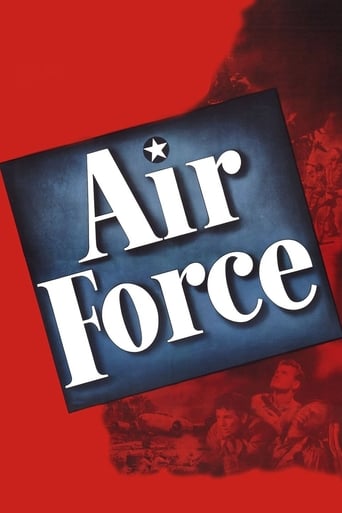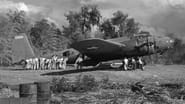JohnHowardReid
A Howard Hawks Production. Producer: Hal B. Wallis. Executive pro¬ducer: Jack L. Warner. Copyright 20 March 1943 by Warner Bros. Pictures, Inc. A Warner Bros.-First National Picture. New York opening at the Hollywood: February 1943. U.S. release: 20 March 1943. Australian release: 3 May 1945. 11,421 feet. 127 minutes.SYNOPSIS: December 1941. The adventures of the U.S. fighter bomber "Mary Ann" in the Pacific theater of war.NOTES: George Amy won the Academy of Motion Picture Arts and Sciences' award for Film Editing, defeating Owen Marks (Casablanca), Doane Harrison (Five Graves to Cairo), Sherman Todd and John Link (For Whom the Bell Tolls), and Barbara McLean (The Song of Bernadette). Air Force was also nominated for Original Screenplay (lost to Princess O'Rourke by Norman Krasna); Cinematography - black-and-white (lost to Arthur Miller for The Song of Bernadette); and Special Effects (lost to Crash Dive).Air Force was selected by Bosley Crowther of the New York Times as one of the Ten Best Films of 1943. One of the seventeen critics in the New York Film Critics panel voted Air Force as the number one film of the year. (That critic was not Mr Crowther, who voted for the ultimate winner, Watch on the Rhine). Air Force was selected as number three on the National Board of Review list (behind The Ox-Bow Incident and Watch on the Rhine).Domestic gross: $2,700,000.COMMENT: Many World War 2 propaganda films now appear excessively dated to-day. Unfortunately, Air Force is no exception. The characters are the usual reluctantly gung-ho types, the dialogue is forced and the incidents strained. Even the action sequences are undermined by obvious process and model work.The players do what they can with their two-cent parts, acting out all the false camaraderie with a too-eager patina of sincerity. Hawks' deliberately eye-level direction comes across as strictly pedestrian. Even Howe's photography (particularly in its ineptly filtered day-for-night sequences) is not up to his usual classy standard - though he was doubtless striving to give the film a grainy, "washed-out" (i.e. an image with no highlights) newsreel look. As for Amy's Award-winning film editing, it's routine "hand me another shot of that stock footage" stuff which doesn't light a candle to Casablanca.Hawks' auteurist admirers will find plenty of their hero's usual "themes", but most viewers will be either bored silly or downright irritated by such unlikely and phony devices as the rebel who turns into a hero, the "lovable" little dog who becomes the bomber's mascot, the softly-spoken Southern officer-gentleman who is actually made of steel, the rough-voiced sergeant whose heart is chockers full of loving kindness, etc., etc. 127 minutes of such drearily dated clichés is more than enough for any man. I hope I never see Air Force again.
nudemink
Must-see comedy for all military aviation veterans! This movie does for (Air)Crew Resource Management what reflective belts do for ground safety.An encrypted twx arrives at San Rafael tasking the bomb wing to send seven B-17s to Hickam Field. The group commander briefs the officers that the enlisted men don't know their destination and there's no reason to tell them. Then screenwriter Dudley Nichols betrays his past as star reporter and feature writer for the New York Post: the colonel tells the officers it's okay to telegraph their wives about the deployment!Writer fatigue? Slip of the typewriter? B-17 crew chief Harry Carey tells his pilot, "Sir, the men don't know where we're going." The pilot's response inspires confidence in the crusty master sergeant and boosts his morale, "Sergeant, can you keep a secret?" "Yes, sir." And then the boot to the back of the neck, "Good."Grab some popcorn. There's more. Right after take-off a hitchhiking fighter pilot points out to his chauffeurs the target-like nature of the B-17 and the god-like qualities of pointy nosed aircraft aviators. Such remarks are best saved until final approach. In real life the aircraft commander would suddenly discover a malfunction and order an emergency bailout over the Farallones. "You go first. You're the guest."A stowaway canine mascot threatens to disrupt the mission, but the sly, crafty, always worth watching senior NCO conceals the subterfuge until well past the Farallones. What's a pilot to do? They're saving the extra chute for the fighter jock. "Okay, you can keep the dog. (But I don't want it peeing on the bomb sight.)"The same senior NCO somehow fathered a lieutenant who flies fighters at Clark Field. Harry Carey relates to every one, many times, deep concern for his son's welfare in the war zone. At Clark the decisive aircraft commander asks about the son and learns that despite his god-like qualities inferior genes have prevailed and the heroic son became a strafe target for Jap zeros while taking off to engage the enemy. The screenwriter and/or film editor allocate thirty seconds for the scene where the NCO gets his dead son's insignia and ribbons (apparently they had medal inflation in 1941.) This scene inspired the old military joke about how to break bad news. "All those men with sons flying fighters at Clark take one step forward. Sergeant, get back in line."More hilarity ensues but I'm switching over to a Gene Autrey movie.
wes-connors
On December 6, 1941, a group of nine Air Force men assemble for a what is hinted to be a secret mission; they board a B-17 named "Mary-Ann" in San Francisco, and take off for Honolulu. Pilot John Ridgely (as "Irish"), co-pilot Gig Young (as Bill), bombardier Arthur Kennedy (as Tommy), navigator Charles Drake (as "Monk"), crew chief Harry Carey (as Robbie), assistant crew chief George Tobias (as Weinberg), radio operator Robert Wood (as Peterson), assistant radio operator Ray Montgomery (as Chester), and aerial gunner John Garfield (as Joe Winocki) hear "Japs" on their radio, while flying over the Pacific Ocean. Yes, they are headed to Hawaii as the treacherous Japanese are attacking Pearl Harbor! Upon landing, the crew tour the demolished United States base. After hearing the cries of a blinded child, they visit a wounded woman who is both Mr. Kennedy's sister and Mr. Young's girlfriend. The men listen to president Franklin D. Roosevelt ask Congress to declare WAR as they, joined by James Brown (as Tex Rader), head for action in Manila, Philippines. Howard Hawks' "Air Force" is a mostly exciting, well-produced World War II propaganda film; director Hawks effectively inserts actual wartime footage. The characters do not turn out to be as interesting or diverse as you're led to believe; but, they serve their purpose well. With guys like these, those Japanese invaders never stood a chance!****** Air Force (2/3/43) Howard Hawks ~ John Garfield, Gig Young, Arthur Kennedy
vincem41
To those people who are so caught up in political correctness that they can not for the life of them watch a period film without smugly pointing out all of "incorrect" and "offensive" parts, thus enhancing their own "moral superiority" and "self-esteem" – I say please stop watching movies made before your twenty-first birthday. That way you will not be offended and will not have to deal with reality. Look kiddies – it was 1943, the Japanese had just attacked Pearl Harbor, they had perpetrated the Bataan Death March and the Rape of Nanking. They were on nobody's short list of nice guys. The were in fact "F***ing Japs", "Slopeheads" and a whole lot of other non-printable epithets, By the way, at the same time the Germans were "Krauts", "Squareheads" and "F***ing Nazis" – Italians were universally referred to a "Wops", "Dagos" & "Greaseballs"- by the way all of my uncles who fought in the ETO were Italian-American - and they used the "nicknames" for Italians. They were the enemy. Get over it!!! Speaking from experience, when someone is actively engaged in trying to kill you, and you him, you could care less about political correctness or the ENEMY'S feelings. They are the enemy – thus for me, they will ALWAYS be "Gooks" and "Gomers" and if that hurts their feelings – oh well!! By the way, despite the best efforts of the government and the political correctness mafia – today's combat troops refer to the bad guys as "Rag Heads" and "Muji's". Again, deal with it.Also – 1943 – we barely had enough planes to fight the war, (thanks to the pre-war peace lobby) let alone make movies with them. The fact that the P-39 was somewhat less than a stellar performer just might be the reason that it was available to make this movie, among other "inconsistencies. The fictional battles and actions were a result of the fact that when this film was made there were very few Air Force victories to brag about in the Pacific – yes it was "propaganda" – so what? Finally, many of you use the word "propaganda" like it's a bad thing. Perhaps you feel that we shouldn't be all "Rah, Rah" for our side?? Whose side should we be "Rah, Rah" for? Or do you think in a war you should remain "neutral", not caring which side wins, just so long as "your" nominal side retains the moral high ground. Well hell, Belgium had the moral high ground in two world wars – ask them how they enjoyed it.




